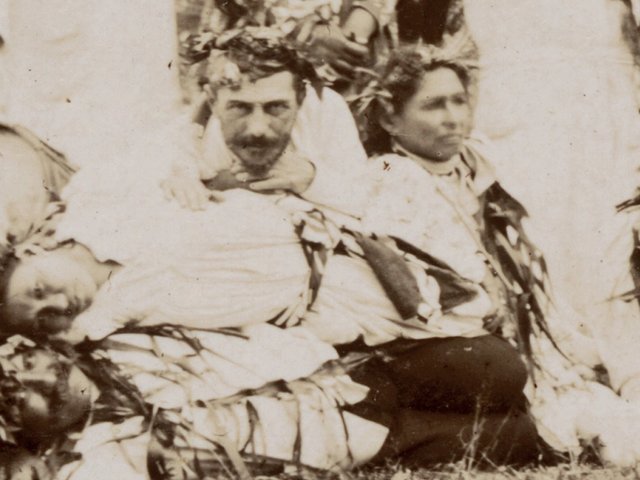Dr Gouzer, a ship’s doctor, is a crucial link helping to confirm the identification of Gauguin in two group photographs, since he and his ship, the Duguay-Trouin, appear in the Agostini album.
Identified by The Art Newspaper as Joseph Gouzer (born 1854, died 1901), he appears in the Blau album as “Docteur G”, standing intimately close to a Tahitian woman, Faona. His descendants have confirmed he is the man in the photo.
The friendship between Dr Gouzer and Gauguin has been largely overlooked (his first name is not cited in the Gauguin literature). Intriguingly, he was a specialist on morphine and in 1896, the year of his Tahitian visit, he published a book entitled Journal d’un Morphinomane, based on a diary by a medical colleague who had died of morphine addiction in what is now Vietnam. At that time Gauguin was regularly taking morphine to dull the pain of ulcers on his legs.
Gouzer was one of the very few buyers of Gauguin’s work in Tahiti—he bought Three Tahitian Women (for 100 francs). It was subsequently acquired by Walter Annenberg, who bequeathed it to New York’s Metropolitan Museum of Art in 2002. Gauguin also gave Gouzer two drawings, including Study of Two Tahitian Heads (1896-97), which is now at the Art Institute of Chicago.
It is possible that Gouzer and Gauguin first met at the hospital in Papeete. Gauguin was there for treatment on his leg, from 6 to 14 July 1896. On 13 July he wrote to his friend Daniel de Monfreid to say that an officer would be taking “several clumsy canvases” to France.
Gouzer’s ship, the Duguay-Trouin, stopped at Tahiti several times, and in March 1897 Gouzer carried some of Gauguin’s paintings back to Paris.
Only one letter from Gauguin to Gouzer survives, from 1898, when the artist wrote: “I cannot contemplate returning to France, as you advise me... I have not said everything about Tahiti [in paint].”




